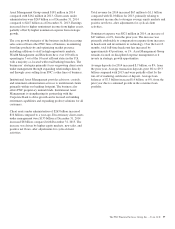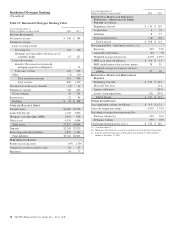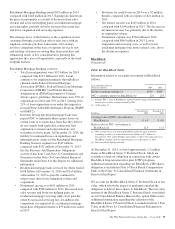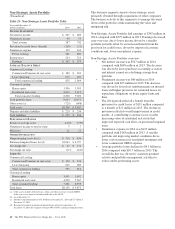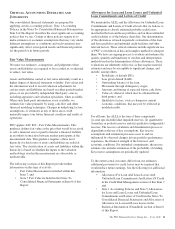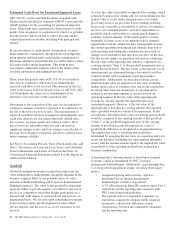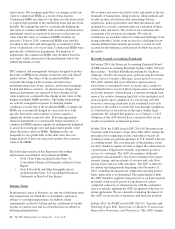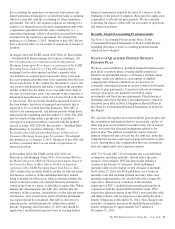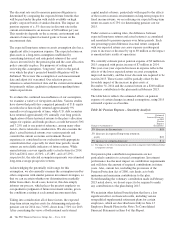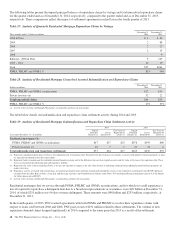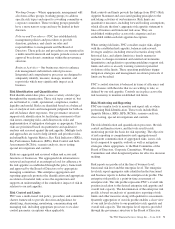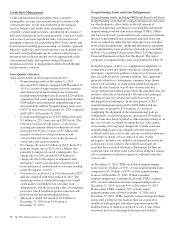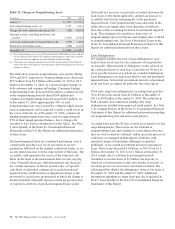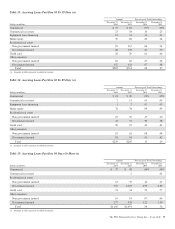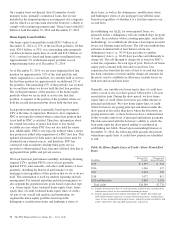PNC Bank 2014 Annual Report Download - page 84
Download and view the complete annual report
Please find page 84 of the 2014 PNC Bank annual report below. You can navigate through the pages in the report by either clicking on the pages listed below, or by using the keyword search tool below to find specific information within the annual report.
The discount rate used to measure pension obligations is
determined by comparing the expected future benefits that
will be paid under the plan with yields available on high
quality corporate bonds of similar duration. The impact on
pension expense of a .5% decrease in discount rate in the
current environment is an increase of $18 million per year.
This sensitivity depends on the economic environment and
amount of unrecognized actuarial gains or losses on the
measurement date.
The expected long-term return on assets assumption also has a
significant effect on pension expense. The expected return on
plan assets is a long-term assumption established by
considering historical and anticipated returns of the asset
classes invested in by the pension plan and the asset allocation
policy currently in place. For purposes of setting and
reviewing this assumption, “long term” refers to the period
over which the plan’s projected benefit obligations will be
disbursed. We review this assumption at each measurement
date and adjust it if warranted. Our selection process
references certain historical data and the current environment,
but primarily utilizes qualitative judgment regarding future
return expectations.
To evaluate the continued reasonableness of our assumption,
we examine a variety of viewpoints and data. Various studies
have shown that portfolios comprised primarily of U.S. equity
securities have historically returned approximately 9%
annually over long periods of time, while U.S. debt securities
have returned approximately 6% annually over long periods.
Application of these historical returns to the plan’s allocation
ranges for equities and bonds produces a result between 6.50%
and 7.25% and is one point of reference, among many other
factors, that is taken into consideration. We also examine the
plan’s actual historical returns over various periods and
consider the current economic environment. Recent
experience is considered in our evaluation with appropriate
consideration that, especially for short time periods, recent
returns are not reliable indicators of future returns. While
annual returns can vary significantly (actual returns for 2014,
2013 and 2012 were +6.50%, +15.48%, and +15.29%,
respectively), the selected assumption represents our estimated
long-term average prospective returns.
Acknowledging the potentially wide range for this
assumption, we also annually examine the assumption used by
other companies with similar pension investment strategies, so
that we can ascertain whether our determinations markedly
differ from others. In all cases, however, this data simply
informs our process, which places the greatest emphasis on
our qualitative judgment of future investment returns, given
the conditions existing at each annual measurement date.
Taking into consideration all of these factors, the expected
long-term return on plan assets for determining net periodic
pension cost for 2014 was 7.00%, down from 7.50% for 2013.
After considering the views of both internal and external
capital market advisors, particularly with regard to the effects
of the recent economic environment on long-term prospective
fixed income returns, we are reducing our expected long-term
return on assets to 6.75% for determining pension cost for
2015.
Under current accounting rules, the difference between
expected long-term returns and actual returns is accumulated
and amortized to pension expense over future periods. Each
one percentage point difference in actual return compared
with our expected return can cause expense in subsequent
years to increase or decrease by up to $9 million as the impact
is amortized into results of operations.
We currently estimate pretax pension expense of $9 million in
2015 compared with pretax income of $7 million in 2014.
This year-over-year expected increase in expense reflects the
effects of the lower expected return on asset assumption,
improved mortality, and the lower discount rate required to be
used in 2015. These factors will be partially offset by the
favorable impact of the increase in plan assets at
December 31, 2014 and the assumed return on a $200 million
voluntary contribution to the plan made in February 2015.
The table below reflects the estimated effects on pension
expense of certain changes in annual assumptions, using 2015
estimated expense as a baseline.
Table 26: Pension Expense – Sensitivity Analysis
Change in Assumption (a)
Estimated
Increase/(Decrease)
to 2015
Pension
Expense
(In millions)
.5% decrease in discount rate $18
.5% decrease in expected long-term return on
assets $22
.5% increase in compensation rate $ 2
(a) The impact is the effect of changing the specified assumption while holding all other
assumptions constant.
Our pension plan contribution requirements are not
particularly sensitive to actuarial assumptions. Investment
performance has the most impact on contribution requirements
and will drive the amount of required contributions in future
years. Also, current law, including the provisions of the
Pension Protection Act of 2006, sets limits as to both
minimum and maximum contributions to the plan.
Notwithstanding the voluntary contribution made in February
2015 noted above, we do not expect to be required to make
any contributions to the plan during 2015.
We maintain other defined benefit plans that have a less
significant effect on financial results, including various
nonqualified supplemental retirement plans for certain
employees, which are described more fully in Note 13
Employee Benefit Plans in the Notes To Consolidated
Financial Statements in Item 8 of this Report.
66 The PNC Financial Services Group, Inc. – Form 10-K



